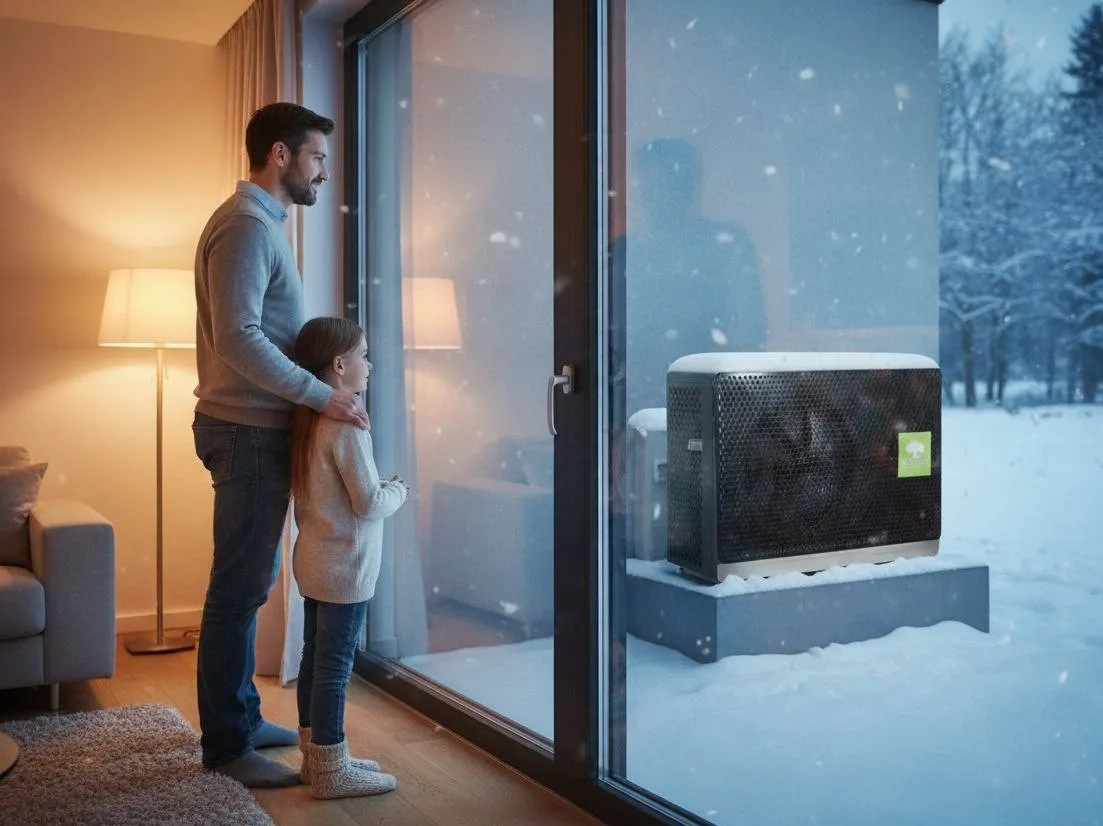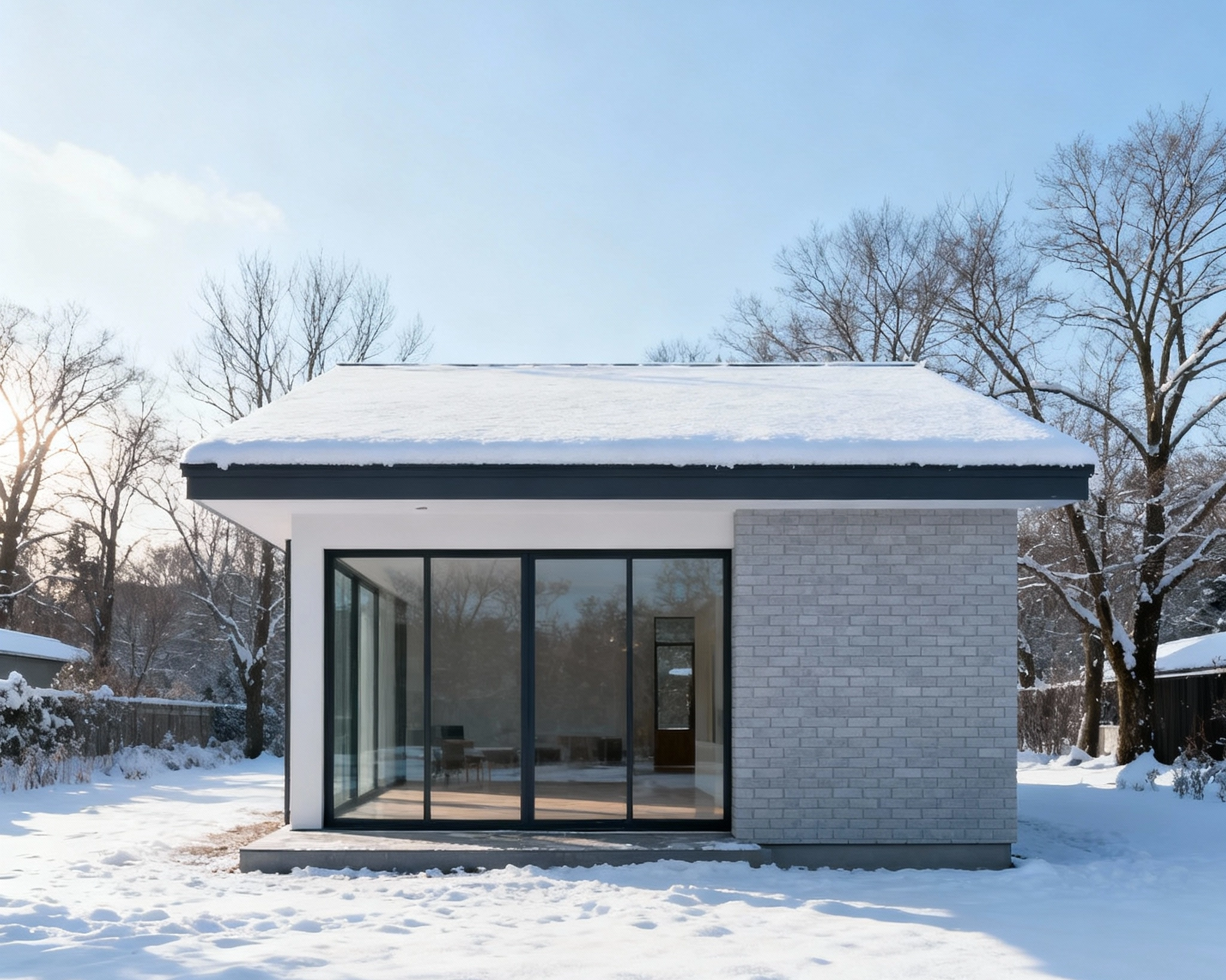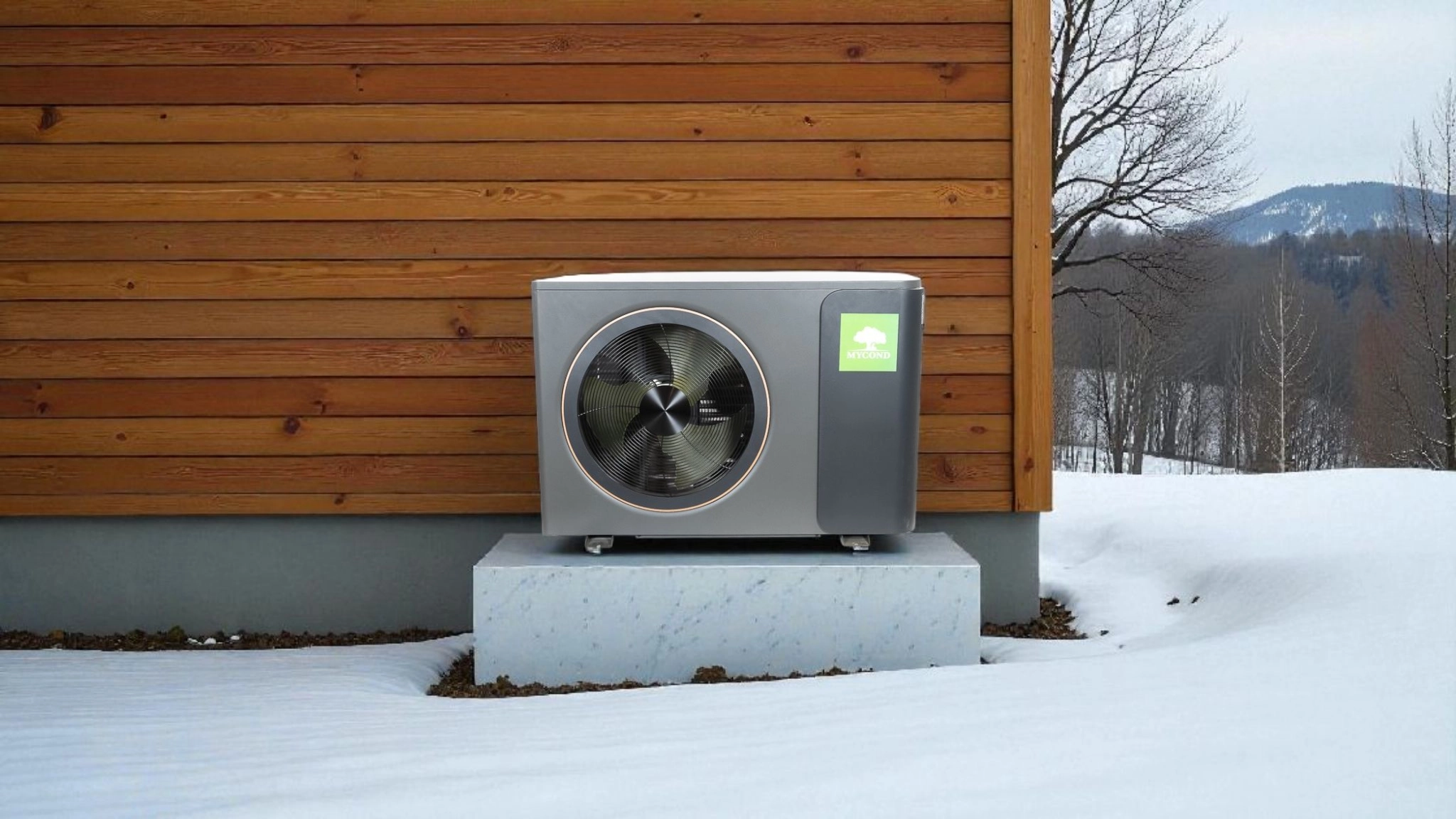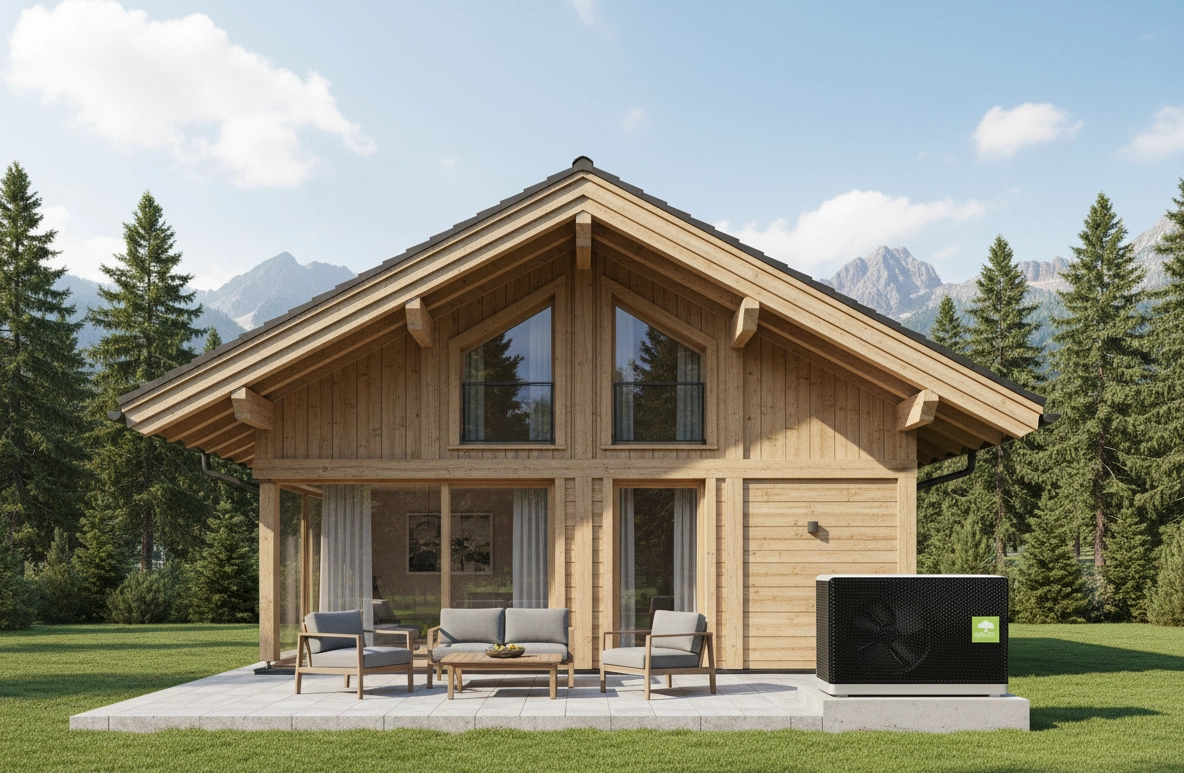
The Mycond air-to-water heat pump is an optimal modern solution for heating a 100 m² home. This technology combines high energy efficiency, environmental friendliness, and electricity savings compared with traditional heating systems. It works by extracting thermal energy from the outdoor air even at low temperatures down to -25°C and converting it into heat to warm your home.
Thanks to inverter technology, the heat pump automatically adapts to changes in outdoor temperature, providing the required amount of heat with minimal electricity consumption. The COP reaches 4–5, which means for every 1 kW of electricity consumed you get 4–5 kW of thermal energy. That is 4–5 times more efficient than a conventional electric boiler. In addition, Mycond heat pumps provide heating in winter and cooling in summer (especially with fan coils), ensuring year-round comfort in your home.
Why 100 m² floor area is not the only metric for selecting a heat pump
Choosing the right model is not just about the 100 m² area. First and foremost, you need a calculation of the actual heat losses, which can differ by a factor of four (from 3 to 12 kW) depending on the quality of the house’s insulation. But that’s not all!
Critically important to understand: the nominal capacity of a heat pump is quoted under ideal conditions: +7°C outdoor air and +35°C water outlet temperature. In real winter conditions at -15°C and +55°C for old radiators, the capacity drops by 2–3 times. Therefore, selecting a heat pump is not just heat loss divided by nominal capacity; it’s a more complex calculation.
This article provides a detailed explanation of the critical difference between nominal and real capacity, a simple method for calculating heat loss, and 4 specific selection scenarios with verification of the real output of the chosen models under design conditions — without complicated tables, but with honest figures.

Express method for calculating heat loss according to thermal engineering standards
For a quick indicative calculation of heat loss for a 100 m² house, you can use normative specific heat-loss values per square metre:
- New energy-efficient homes: 30–50 W/m² — for 100 m² this is 3–5 kW
- Modernised homes: 50–70 W/m² — for 100 m² this is 5–7 kW
- Old uninsulated homes: 100–120 W/m² — for 100 m² this is 10–12 kW
The formula for calculating the required heat pump capacity: heat loss × 1.1 (10% safety factor).
Example calculation: old 100 m² house, 110 W/m².
100 × 110 = 11,000 W or 11 kW of heat loss
11 kW × 1.1 = 12.1 kW
Important! This is the heat output required at your region’s design temperature (typically from -10°C to -25°C), not the heat pump’s nominal capacity quoted by the manufacturer at +7°C.
This is an indicative quick calculation. For an accurate calculation considering all factors (ceiling height, number and quality of windows, building orientation, wall thickness) it is best to consult professionals. However, the stated norms provide a good guide for selecting a model. The main thing is to understand the difference between nominal and real capacity.
CRITICALLY IMPORTANT: nominal versus real heat pump output
The nominal capacity quoted by the manufacturer (for example, 9 kW or 12 kW) is the capacity under standard test conditions: +7°C outdoor air and +35°C water outlet temperature (denoted as A7/W35 according to European standard EN 14511). These are ideal conditions for a heat pump: high COP, maximum efficiency.
However, in real winter operation the conditions are very different: the outdoor temperature may be -10, -15, -20°C, and the water temperature required for old radiators is +50–55°C. Under such conditions, a heat pump’s capacity drops by 1.5–3 times depending on the model and technology.
Let’s look at the capacity drop using the BeeSmart MHCS035 with a nominal capacity of 9 kW as an example:
- +7°C/W35: real output 9.2 kW (100% of nominal), COP 4.48
- -7°C/W35: real output 5.7 kW (62% of nominal), COP 2.97
- -15°C/W35: real output 4.4 kW (48% of nominal), COP 2.40
- -7°C/W55: real output 4.88 kW (53% of nominal), COP 1.73
- -15°C/W55: real output 3.63 kW (39% of nominal), COP 1.39
Critical takeaway: if your home has heat losses of 9 kW at -15°C and requires a water temperature of +55°C for old radiators, then the BeeSmart heat pump with a 9 kW nominal will deliver only 3.63 kW of real output, which is absolutely insufficient! You need a heat pump with at least 19–24 kW nominal capacity or a bivalent scheme (a smaller heat pump plus a backup boiler).
This is the most common mistake when selecting equipment — people look only at nominal capacity and do not consider real operating conditions. All manufacturers provide detailed performance tables at different temperatures. You must always look at real output at your region’s design temperature and at the required water temperature: W35 for underfloor heating, W45–50 for low-temperature radiators, W55 for old radiators. These figures — not the nominal — determine whether the model is suitable.

Overview of the three Mycond series
- Models: MHM-U06HL (7.2 kW), MHM-U09HL (9.7 kW), MHM-U12HL (11.9 kW)
- Compressor: Zhuhai Landa
- SCOP: 4.50–4.65 (A+++ class at W35)
- Features: monoblock design, basic functionality, remote control, Mycond app, special heat exchanger coating, operation down to -25°C
- For whom: private residential homes with a simple heating scheme (single circuit), optimal balance of capability and simplicity without overpaying for extra features
BeeSmart
- Models: MHCS035 NBS/UBS (9 kW), MHCS045 NBS/UBS (12 kW), MHCS050 NBS/UBS (15 kW), MHCS070 NBS/UBS (19 kW)
- Compressor: Mitsubishi Electric
- SCOP: 4.72–4.98 (the highest among Mycond, A+++ class)
- Features: split system or AIO (all-in-one) with indoor hydraulic module and DHW tank, weather-compensated control, smart control of two circuits via mixing valves, Modbus integration, smart home, Smart Grid, compressor frequency up to 90 Hz
- For whom: complex systems with two or more circuits, automation, smart home integration, commercial sites, cascade setups, maximum efficiency and functionality
- Models: MHCM 06 SU1A (6 kW), MHCM 10 SU1A (10 kW), MHCM 14 SU3A (14 kW), MHCM 18 SU3A (18 kW), MHCM 24 SU3A (24 kW)
- Compressor: Panasonic Wanbao with EVI technology (Enhanced Vapor Injection)
- SCOP: 4.47–4.58 (A+++ at W35 and A++ at W55)
- Features: monoblock, EVI technology for extreme frosts (retains 55–65% of capacity at -15°C and 60–70% at -25°C, when conventional heat pumps lose 50–60% of nominal), intelligent defrost, fault tolerance, auto-recovery, operation tested at -25°C
- For whom: cold climate zones where temperatures regularly fall below -15°C, mountainous areas, harsh winters, where stable operation without loss of output in frost is critical; monovalent setup in cold climates
Conclusion: All three series have A+++ class, Heat Pump Keymark certification, R32 refrigerant, and supply temperature up to +55°C, so they are suitable for most heating systems, including old radiators. The difference is in specialisation: MBasic — universal for simple systems, BeeSmart — for complex systems with automation, BeeThermic — for extremely cold climates. But the most important thing when choosing a model is to look not only at nominal capacity, but at the real output under your specific operating conditions.

Practical selection scenarios with verification of real output
Scenario A: New energy-efficient home
Characteristics: heat losses 4 kW (100 m² × 40 W/m²), heating system: underfloor heating with a supply temperature of +30–40°C or fan coils with a supply temperature of +35–45°C, temperate climate zone (design temperature -15°C).
Recommendation: Mycond MBasic MHM-U06HL (nominal capacity 7.2 kW).
Real output check: at -15°C/W35 the MHM-U06HL delivers approximately 4.5–5 kW of real output, which is more than the heat loss (4 kW), so it is an ideal fit.
Rationale: A low-temperature system (underfloor heating or fan coils, W35) allows a high COP (4.3–4.5) even at -15°C. The heat pump retains 60–70% of nominal capacity, which is sufficient to cover 4 kW heat loss with reserve. A monovalent scheme without a backup source is the most economical option to operate.
Alternative: BeeSmart MHCS035 (9 kW nominal) if complex automation, weather-compensated control or smart home integration (Modbus) is planned. But for a simple house with a single heating circuit this functionality is excessive.
Scenario B: Modernised home with a combined system
Characteristics: heat losses 7 kW (100 m² × 70 W/m²), heating system: combined (underfloor heating on the ground floor plus low-temperature radiators or fan coils on the first floor, supply temperature +45–50°C), temperate climate zone (design temperature -15°C).
Recommendation: MBasic MHM-U09HL (nominal capacity 9.7 kW).
Real output check: at -15°C/W45 the MHM-U09HL delivers approximately 6–6.5 kW of real output, which is less than the 7 kW heat loss, but sufficient for a bivalent point at -10°C (it delivers 7–8 kW, fully covering the load).
Rationale: For such a system, a light bivalent setup is optimal. The MHM-U09HL heat pump operates alone down to the bivalent point (approximately -10°C), which covers 85–90% of the heating season. At lower temperatures (-10 to -20°C) a small electric backup (2–3 kW) is automatically enabled to maintain comfort.
Alternative: BeeSmart MHCS045 (12 kW nominal) if control of two circuits with different temperature programmes via mixing valves is required (ground floor — underfloor heating +35°C, first floor — radiators +50°C) with automatic calculation of the optimal temperature for each circuit, or Smart weather-compensated control for automatic optimisation.
Scenario C: Old house with old radiators
Characteristics: heat losses 11 kW (100 m² × 110 W/m²), heating system: old cast-iron or steel radiators requiring a supply temperature of +50–55°C, temperate climate zone (design temperature -15°C).
Recommendation: MBasic MHM-U12HL (nominal capacity 11.9 kW) plus a MANDATORY bivalent scheme with a backup source (electric boiler 4–5 kW or an existing gas boiler).
Real output check: Critically important — at -15°C/W55 the MHM-U12HL delivers only 5–6 kW of real output. This is less than half the nominal (11.9 kW) and absolutely insufficient for 11 kW heat loss, so a monovalent scheme is impossible.
Rationale for the bivalent scheme: The MHM-U12HL heat pump covers the base load down to the bivalent point (approximately -7°C). At this temperature and W55 it delivers around 7–8 kW, which is sufficient for the home’s heat loss at -7°C. At lower temperatures (-7 to -20°C) the backup boiler (4–5 kW) is automatically enabled to add the required output.
Alternative: BeeThermic MHCM 14 SU3A (14 kW nominal) if you are in a region with frosts below -15°C, where EVI technology provides an advantage. At -15°C/W55 the BeeThermic MHCM 14 SU3A delivers 10.25 kW of real output (73% of nominal), almost twice as much as conventional heat pumps, thanks to EVI (Enhanced Vapor Injection).
Scenario D: Cold climate with prolonged frosts
Characteristics: any 100 m² house type, heat losses 8 kW, climate zone with regular temperatures below -15°C and frosts down to -25°C for weeks, heating system: any (radiators, fan coils, underfloor heating), water temperature W45.
Recommendation: BeeThermic MHCM 14 SU3A (nominal capacity 14 kW), specifically because of the EVI technology.
Real output check: A critical calculation — heat losses are 8 kW at -15°C, but at -25°C the losses increase by a further 25–30% to 10–10.4 kW. A conventional MBasic or BeeSmart heat pump with a 12 kW nominal at -25°C/W45 delivers only 4–5 kW of real output (33–42% of nominal). The BeeThermic MHCM 14 SU3A with EVI technology at -25°C/W45 delivers 7.34 kW (52% of nominal).
Rationale: For cold climates with prolonged harsh winters, only EVI technology provides reliable, stable operation without critical loss of capacity at extreme frosts. Enhanced Vapor Injection adds an auxiliary heat exchanger and a vapour injection valve to the compressor, which increases performance at low temperatures when refrigerant pressure drops.

Monovalent versus bivalent schemes — when each is more advantageous
There are two main heat pump operating schemes:
Monovalent scheme: The heat pump operates alone, without a backup source, covering 100% of the heat loss at any temperature. Suitable for well-insulated homes with low heat losses (30–50 W/m²) and low-temperature systems (underfloor heating, fan coils, W35–40) and temperate climates without prolonged frosts below -10…-15°C, or for cold climates with BeeThermic EVI.
Bivalent scheme: The heat pump covers the base load (70–85% of the heating season), and during peak frosts below the bivalent point, a backup boiler (electric or gas) switches on automatically. Suitable for old homes with high heat losses (100–120 W/m²) and high-temperature systems (old radiators, W50–55), or for temperate climates where it is more cost-effective to install a less powerful heat pump plus a small backup (3–5 kW) than a very powerful monovalent heat pump.
The bivalent point is the outdoor temperature at which the real output of the heat pump can no longer cover the home’s heat losses and a backup source is needed. Typically the bivalent point is around -5 to -10°C for most systems.
Calculation of the bivalent point depends on the heat pump’s nominal capacity, the heating system (water temperature) and the home’s heat losses.
Example: old 100 m² house, heat losses 11 kW at -15°C, heating system — old radiators (W55). We install the MBasic MHM-U12HL (11.9 kW nominal). At -7°C/W55 it delivers about 7–8 kW of real output. The home’s heat loss at -7°C decreases linearly to approximately 6–7 kW. The heat pump fully covers it; the bivalent point is at -7°C. At lower temperatures the 5 kW electric boiler switches on.
Types of heating systems and their impact on power selection
Underfloor heating (supply temperature +30–40°C): the most optimal option for a heat pump. All three Mycond series operate with maximum COP (4.3–5.0); even at -15°C they retain 60–70% of nominal capacity. The most economical operation, suitable for all series; a monovalent scheme is feasible.
Fan coils (supply temperature +35–45°C): universal fan-assisted emitters. Main advantage — dual function: heating in winter, cooling in summer when the heat pump is switched to cooling mode. The temperature is optimal for a high COP; rooms heat up quickly thanks to forced air circulation (unlike radiators). At -15°C/W40 heat pumps retain 55–65% of nominal capacity. Ideal for all three Mycond series, especially BeeSmart, which has an automatic heating–cooling switching function for year-round comfort.
Low-temperature radiators (supply temperature +45–50°C): modern aluminium or bimetal radiators with a large surface area designed to work with heat pumps. All three series operate with a COP of 3.0–3.8. At -15°C/W45 heat pumps retain 45–55% of nominal capacity. Suitable for heating modernisation; a light bivalent scheme is often needed.
Old cast-iron or steel radiators (supply temperature +50–55°C): all three Mycond series provide up to +55°C, so they are suitable for modernisation without replacing radiators, but COP at W55 is significantly lower (2.0–2.8). At -15°C/W55 heat pumps retain only 35–45% of nominal capacity. It is critically important to account for this drop when selecting a model. For old radiators, a bivalent scheme is almost always required.
Heat pump installation
Monoblock (MBasic and BeeThermic): all components in a single outdoor unit. Advantages: no refrigerant lines needed, simpler permits, faster installation.
Split system (BeeSmart): outdoor unit plus indoor hydraulic module. Advantages: compact outdoor unit, indoor module in the plant room, convenient, more flexibility. Disadvantage: refrigerant lines are required.
Three hydraulic connection schemes:
- Direct — for simple systems (single circuit)
- Via hydraulic separator — for multiple circuits
- With a buffer tank (100–300 litres) — recommended for all systems
The buffer tank compensates for losses during defrost, stores heat, ensures stable system operation, and allows you to use dynamic electricity tariffs for maximum savings.
FAQ - Frequently asked questions
How can I calculate the heat loss of a 100 m² house myself?
Multiply the 100 m² area by the specific heat loss: for a new home (30–50 W/m²) — 3–5 kW, for a modernised one (50–70 W/m²) — 5–7 kW, for an old one (100–120 W/m²) — 10–12 kW. Then multiply by 1.1 as a safety factor. This is a quick express calculation for a preliminary model choice.
Why is the nominal 9 kW, but it only delivers 4 kW in reality?
Nominal capacity is quoted under standard test conditions: +7°C outdoor air, W35 (water temperature). These are ideal conditions. In reality, in winter at -15°C/W55 for old radiators, capacity drops by 2–3 times. This is normal for all heat pumps. You should consult performance tables for your specific operating conditions.
What is the difference between MBasic, BeeSmart and BeeThermic?
MBasic: basic functionality, monoblock, Zhuhai Landa, SCOP 4.50–4.65, for simple systems. BeeSmart: maximum automation, Mitsubishi Electric, SCOP 4.72–4.98 (highest), two circuits, weather-compensation, Modbus, for complex systems. BeeThermic: EVI, Panasonic, SCOP 4.47–4.58, for cold climates, retains 55–65% of output at -15°C.
Is a backup boiler necessary?
It depends on insulation, the heating system, and the climate. For a new home with underfloor heating (W35) in a temperate climate, a monovalent scheme is sufficient. For an old home with old radiators (W55), a bivalent scheme (heat pump plus 3–5 kW backup) is better. For cold climates below -15°C, BeeThermic with EVI is preferable (monovalent) or other series plus a powerful backup.
What are the advantages of fan coils?
Fan coils (supply temperature +35–45°C) are optimal for heat pumps. The main advantage is versatility: heating in winter, cooling in summer. Quick warm-up thanks to the fan, compact, suitable for all Mycond models, especially BeeSmart with automatic mode switching.
Which series is the most efficient?
By SCOP — BeeSmart (4.72–4.98) is the highest. But efficiency depends on conditions: for well-insulated homes at W35 — all work with COP 4.5–5.0; for cold climates — BeeThermic is more effective thanks to EVI; for complex systems — BeeSmart optimises via weather-compensation. The most efficient is the one that suits your conditions.
Conclusion
The correct selection of a heat pump for a 100 m² home is based on four key factors:
- Calculation of real heat losses according to thermal engineering standards
- CRITICALLY IMPORTANT: understanding the difference between nominal and real capacity under your specific operating conditions (nominal is quoted at +7°C/W35, while in reality at -15°C/W55 capacity drops by 2–3 times) — this is the most common mistake
- Determining the type of heating system and the optimal scheme (monovalent for low-temperature systems W35–40 or bivalent for high-temperature W50–55)
- Considering the climate zone and any special requirements
Mycond offers a complete range: MBasic for simple residential systems (optimal balance), BeeSmart for complex systems with automation (highest SCOP up to 4.98, precise model designations MHCS035, MHCS045, MHCS050, MHCS070), BeeThermic for cold climates (unique EVI technology, stable operation at -25°C).
Need help selecting the optimal Mycond model considering real heat losses, real output under your operating conditions, heating system type and climate? Our engineers are ready to provide a free consultation, recommend the optimal model and connection scheme (monovalent or bivalent) with verification of real output at your region’s design temperature. Contact us now via the phone number listed on the page, or fill in the feedback form at the bottom of the page and our specialist will get back to you.
Don’t repeat the common mistake of focusing only on nominal capacity and floor area. Entrust equipment selection to Mycond professionals who will consider all the factors of your specific home and heating system.